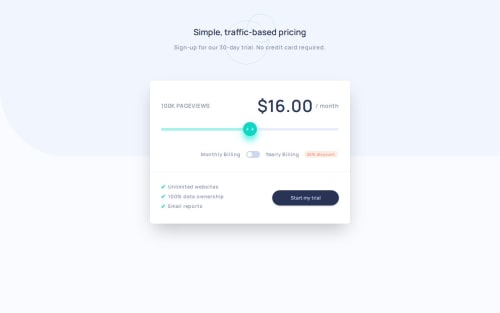Interactive pricing component with Svelte and TailwindCSS

Solution retrospective
Any feedback is welcome! Thanks
Please log in to post a comment
Log in with GitHubCommunity feedback
- @pikapikamart
Hey, awesome work on this one. Layout in general looks great.
Some suggestions would be:
- When wrapping a text-content do not just use
divto wrap it, use meaningful element like aptag if it just a regular text or heading tag if it is an heading. - The range-input currently lacks visual indicator when tabbing on it, it would be great to add some visual on the
:focus-visiblestate of theinput, like giving outline on the slider-thumb. - On the billing-section, you should have not used checkbox on it, rather use radio buttons since it is a selection. Those 2 text besides the toggle are the
labelfor each radio button. You will need to nest the 2 radio buttons inside afieldsetalong with an screen-reader only legend that will described what is the purpose of those radio buttons, it could use a text-content like "billing section". Take a look at this old solution of mine on this challenge though this is a old solution and still haven't refactored yet so that is whyfieldsetandlegendare not used in here but the functionality of the 2 radio buttons are used in here. start my trialbuttonshould have better:focus-visiblestate, right now it is hard to tell whether it has focus or not.- Lastly, maybe wrapping the whole component inside a
formsince this will be a form in real site and thatbuttonshould havetype="submit".
Aside from those, great job again on this one.
- When wrapping a text-content do not just use
Join our Discord community
Join thousands of Frontend Mentor community members taking the challenges, sharing resources, helping each other, and chatting about all things front-end!
Join our Discord